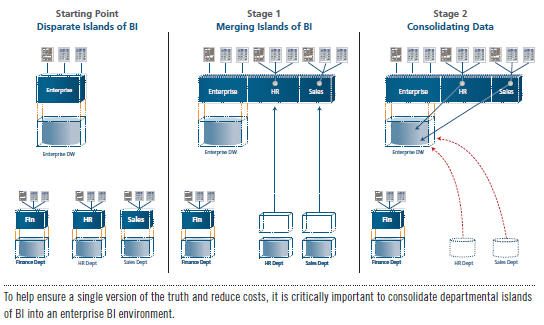LESSON - Evolving from Disparate, Departmental Business Intelligence to a Fully Integrated Enterprise Business Intelligence Environment
By Dan Paladino, Analyst, Industry and Solution Marketing, MicroStrategy
The ideal architecture for BI is an enterprise architecture in which there is a cohesive model of the business represented in a single metadata across all applications. Enterprise architecture helps ensure a single version of the truth by encompassing all data sources, reports, dashboards, and other BI analyses in an organization. It is also the most efficient architecture to own and operate, and incurs a low cost of ownership as a result.
Despite the clear advantages of enterprise BI, achieving it can be a challenge in terms of the political and IT effort it requires. In addition, businesses often cannot wait to achieve fully integrated enterprise BI; quick solutions are a must. Departmental BI islands provide them with fast and nimble BI. As a result, multiple departmental BI systems surface within an organization.
Despite the freedom and flexibility provided by islands of departmental BI, it is not an ideal or long-term solution for a company. As small, independently operated BI applications arise, it becomes inevitable that conflicting versions of the truth do so as well. Since each departmental system consists of its own reports and metadata accessing its own data sources, there is no data uniformity with other departmental or enterprise grade applications.
The cost of maintaining these departmental systems poses another challenge to companies trying to save in a challenging economy. An organization’s resources are rarely shared efficiently, if at all, and the organization cannot benefit from the economies of scale.
To help ensure a single version of the truth and reduce costs, it is critically important to consolidate data and departmental islands into an enterprise BI environment. In order for an organization to evolve to an enterprise architecture, every departmental BI system in the IT landscape—including its metadata objects and data sources—will eventually need to be encompassed within a single, unified metadata.
Ideally, the first stage in the process of consolidating BI islands should not necessarily require the actual movement of data from departmental data sources to the enterprise data warehouse. Instead, the previously distinct metadata definitions should be merged gradually into a unified enterprise metadata that spans the vast collection of databases in the organization. This process must be incremental, with the metadata of each BI island consolidated into the enterprise one at a time. The next stage involves incrementally consolidating all of an organization’s data into an enterprise data warehouse.
However, it is crucial that these stages allow companies to gradually consolidate islands of BI without interrupting their business users. Departmental users should be able to continue to use their BI applications and reports even as they are consolidated to an enterprise architecture. In addition, an organization’s IT group should not be required to redesign any of those reports or other metadata objects because of the data consolidation. This transparency is an essential factor as departmental islands are consolidated.
Even within a larger, overarching enterprise framework, a BI technology must allow individual departments and workgroups to retain their departmental autonomy and nimbleness even as consolidation takes place. Users of departmental BI applications do not (and should not need to) sacrifice their convenient and flexible BI access as the organization works to achieve unified enterprise BI. The most sophisticated enterprise BI environments cater to the needs of both their enterprise and departmental business users.

Summary
Despite the nimbleness of departmental BI, organizations want to eventually achieve enterprise BI, which provides a single version of the truth, high efficiency and performance, and the lowest cost of ownership. This can only be achieved through a gradual, seamless consolidation of BI islands.
For a free white paper on this topic, click here and choose the title “MicroStrategy 9: Breakthrough Technology that Supports the Full Range of Business Intelligence.”